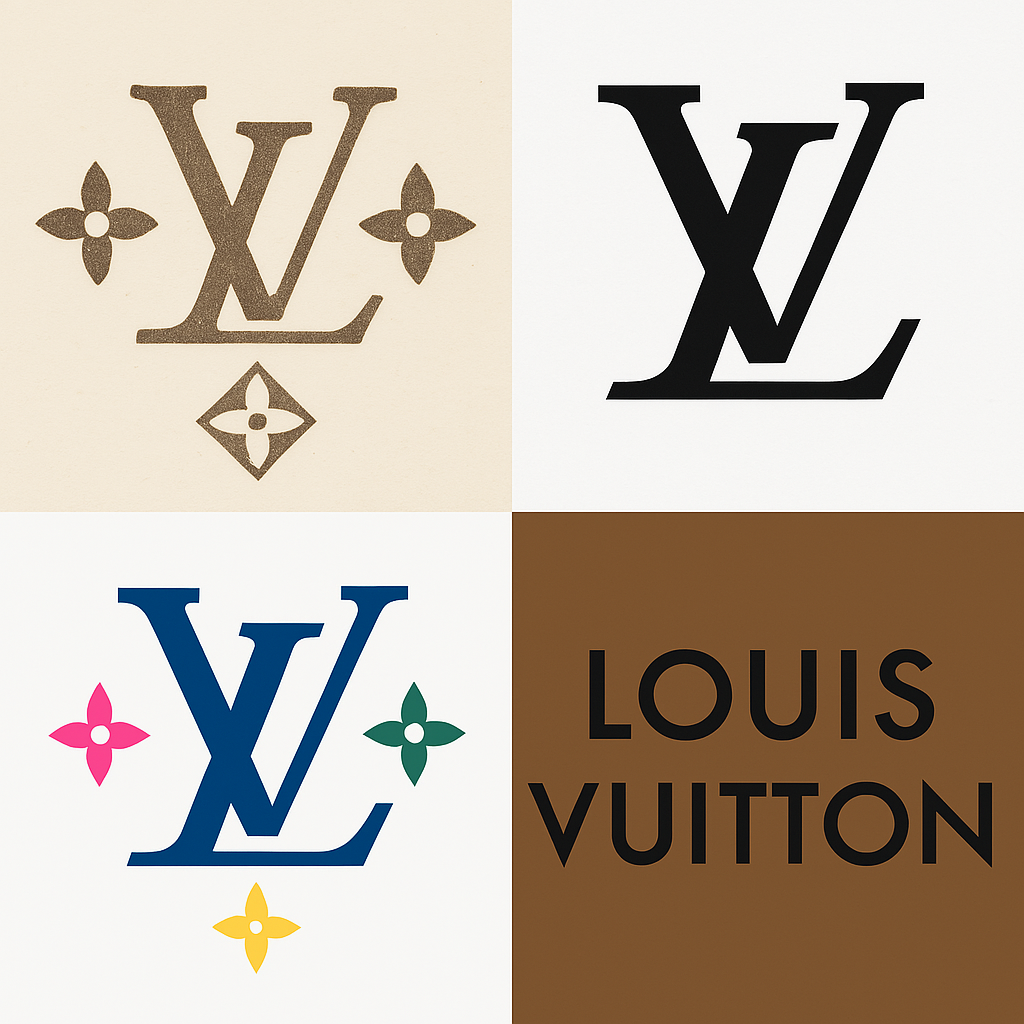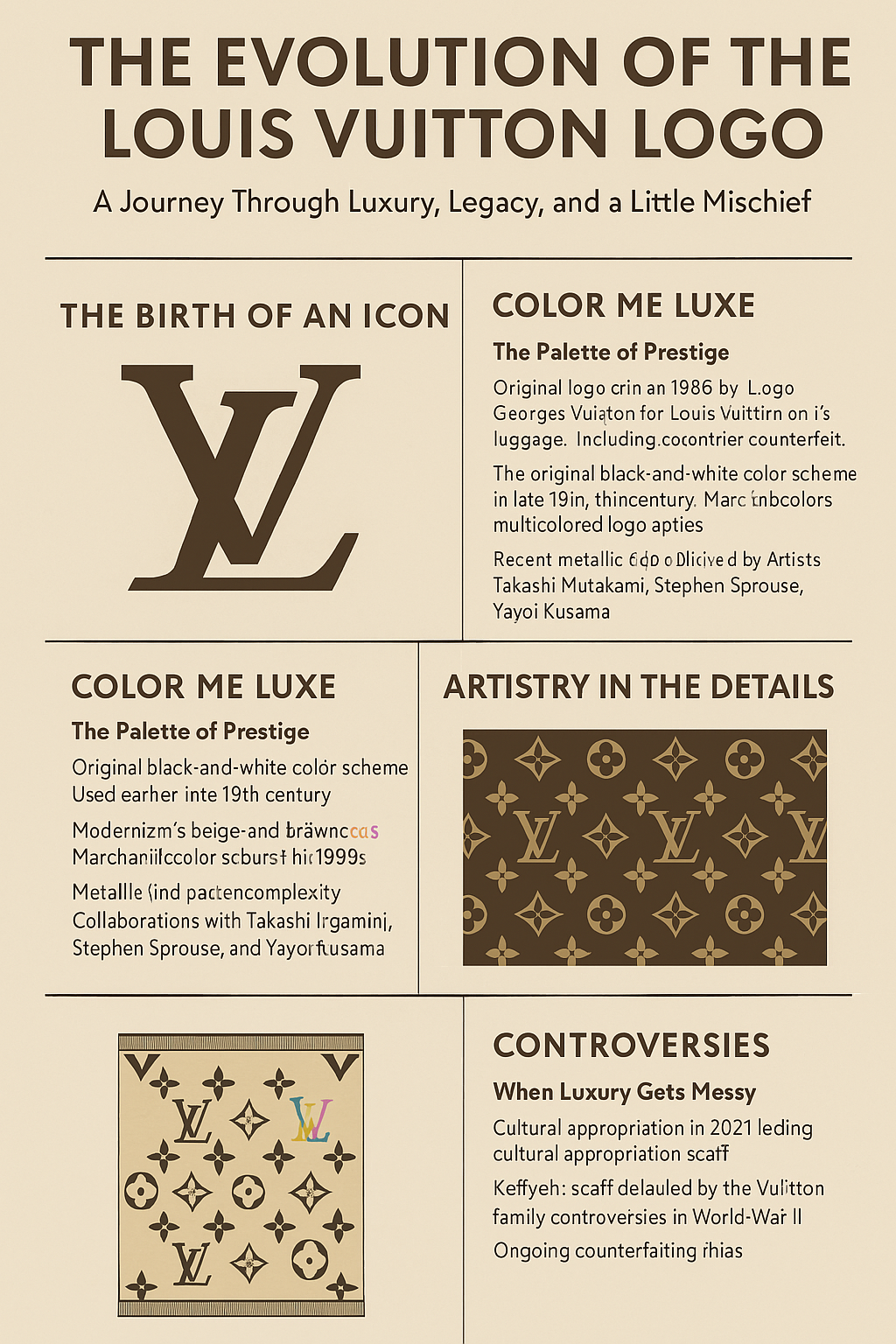When you think of luxury, what pops into your mind? A sleek private jet? A diamond-studded watch? Or maybe—just maybe—that iconic “LV” monogram that whispers, you’ve arrived. The Louis Vuitton logo evolution is a masterclass in branding—from 1896’s anti-counterfeit mission to today’s runway dominance. It’s more than a logo—it’s a legacy, a lifestyle, and a design blueprint for anyone chasing timeless impact.
The Birth of an Icon: Louis Vuitton Logo Evolution Begins
Picture this: it’s 1854, and a young Louis Vuitton is schlepping his way through Paris, dreaming of revolutionizing luggage. Fast forward to 1892, and the man’s dead—but his son, Georges Vuitton, isn’t about to let the family name fade into obscurity. Enter the Louis Vuitton logo in 1896, a monogram born out of necessity and nostalgia. Georges didn’t just slap his dad’s initials on a canvas; he created a shield against counterfeiters plaguing the brand’s waterproof trunks. “I wanted something unmistakable,” Georges might’ve said if he were the chatty type. The result? An interlocking “L” and “V” surrounded by floral motifs—a design so clever it’s still the backbone of the brand today.
This wasn’t some haphazard doodle whipped up on a logo generator by prompt. No, Georges drew inspiration from the Victorian era’s obsession with Japanese art, blending elegance with practicality. The logo’s birth wasn’t just a design choice; it was a declaration: Louis Vuitton was here to stay.

Color Me Luxe: The Palette Behind the Louis Vuitton Logo Evolution
Let’s talk color—because even the best AI logo generator knows it’s not just about shapes. The original Louis Vuitton logo stuck to a classic black-and-white scheme, exuding timeless sophistication. But oh, how the palette has played! By the late 19th century, the Monogram Canvas debuted in that iconic beige-and-brown combo—earthy, rich, and unmistakably luxe. “Brown is the new black,” some Victorian fashionista might’ve quipped, and they wouldn’t be wrong.
Fast forward to the Marc Jacobs era in the late ’90s, and suddenly the monogram’s popping in pink, blue, purple, and yellow—like a candy store explosion on a $5,000 handbag. This wasn’t just a design tweak; it was a nod to a younger, bolder crowd. Today, the logo flirts with metallics (thanks, Nicolas Ghesquière) and even gummy yellows (cheers, Virgil Abloh), proving that luxury can have a sense of humor. Color isn’t just decoration here—it’s storytelling.
Artistry in the Details: Design Genius in the Louis Vuitton Logo
If the Louis Vuitton logo were a painting, it’d be a Picasso—complex yet cohesive. The floral motifs—quatrefoils, stars, and that four-petal flower—aren’t random doodles. They’re a nod to femininity, joy, and the brand’s travel roots. Georges didn’t need a logo maker to tell him that intricate patterns deter knockoffs; he figured that out the hard way as fakes flooded the market.
Then came the collaborations. Takashi Murakami’s 2003 rainbow-hued monogram? Pure pop-art genius. Stephen Sprouse’s graffiti overlay in 2001? Edgy as hell. Yayoi Kusama’s polka dots in 2012? Delightfully bonkers. These artists didn’t just tweak the logo; they remixed it, keeping it fresh while honoring its DNA. “The monogram is a canvas,” Murakami once said, and boy, did he paint it out loud.
Design Patterns: The Monogram That Won’t Quit
The Monogram Canvas isn’t just a pattern—it’s a lifestyle. That beige-on-brown grid, dotted with “LV” and floral flair, has graced everything from trunks to trench coats. Over the years, Louis Vuitton rolled out the Damier (checkerboard vibes) and Epi leather (textured elegance), but the monogram remains king. It’s versatile enough to slap on a sneaker or a spaceship—and trust me, with today’s tech, that spaceship’s not far off.
What’s the secret? Consistency with a twist. The core design hasn’t budged since 1896, but its applications? Endless. It’s a lesson for any logo generator AI free enthusiast: build a strong base, then play.
Controversies in the Louis Vuitton Logo Evolution
Luxury’s not all champagne and roses—sometimes it’s lawsuits and scandals. Take the 2021 Monogram Keffieh scarf: a $700 reinterpretation of a Palestinian symbol in Israeli flag colors. Twitter erupted with cries of cultural appropriation—“If I don’t steal it, someone else will,” memes mocked, quoting a viral repatriation controversy. Louis Vuitton yanked it faster than you can say “PR nightmare.”
Then there’s the WWII stain. Under German occupation, the Vuitton family cozied up to the Nazis, boosting their wealth. “Ancient history,” a spokesperson shrugged decades later, but the logo’s pristine image took a hit. And don’t get me started on counterfeiting—more on that later. Point is, even the shiniest logos have shadows.
Stock Price: The Logo’s Golden Ticket
Let’s talk about cash. Louis Vuitton’s parent company, LVMH, is a behemoth, and the logo’s a big reason why. In 2017, Forbes pegged the brand’s value at $28.8 billion. By 2023, Interbrand clocked it at $124 billion—a 17% jump in a year. LVMH’s 2023 revenue? A cool €79.2 billion, with Louis Vuitton chipping in about 20%. That monogram isn’t just pretty—it’s a money-printing machine.
Why? Because the logo screams exclusivity. It’s the golden goose that keeps investors drooling and stock prices climbing. Next time you’re tinkering with a logo maker, remember: a great design can bankroll an empire.
The Logo’s Role in Defining Eras
The Louis Vuitton logo isn’t just a static symbol—it’s a time machine. In the Victorian era, it marked the dawn of luxury travel. Post-WWII, it signaled resilience with leather goods. The Marc Jacobs years (1997–2013) screamed pop culture relevance—think Murakami’s cherry blossoms. Virgil Abloh’s 2018–2021 menswear stint? Streetwear swagger meets high fashion.
Each era’s tweak reflects the zeitgeist. “How you know the monogram isn’t what matters—it’s that you know it,” Vogue mused in 2018. It’s a chameleon, adapting yet eternal.
Design Lessons from the LV Playbook
Aspiring designers, grab your AI logo generator and listen up. Lesson one: simplicity scales. The “LV” is basic but bold—readable on a billboard or a belt buckle. Lesson two: consistency breeds trust. Over 125 years, the core logo’s barely budged. Lesson three: innovate smart. Collaborations keep it fresh without trashing the heritage.
“Timelessness isn’t about standing still—it’s about evolving with purpose,” a branding guru might say. Louis Vuitton nails it. Your logo doesn’t need to be fancy; it needs to be you.
The Symbolism Powering the Louis Vuitton Logo Evolution
Peel back the layers, and the logo’s a treasure trove of meaning. The “L” and “V” honor a father-son legacy—Louis and Georges, the dreamers. The floral motifs? Joy, femininity, and a nod to travel’s golden age. Gold accents scream opulence; geometric shapes echo precision. It’s not just a logo—it’s a storybook.
For society, it’s a status badge. “If you’ve got this logo, you’ve arrived,” a fashionista might smirk. It’s power, prestige, and a ticket to the elite club.
The Louis Vuitton Logo Evolution’s Influence on Culture
Once upon a time, Louis Vuitton trunks were for empresses and explorers. Today? They’re Instagram flexes and red-carpet staples. The logo’s democratized luxury—sort of. It’s still pricey, but knockoffs and pre-loved pieces spread the “LV” gospel wide. Celebrities like Kim Kardashian and JO1 flaunt it; influencers hashtag it. It’s not just fashion—it’s a lifestyle.
Yet, it’s divisive. Some see it as aspirational; others, ostentatious. “LV” sparks debates on wealth, consumerism, and identity—proof a logo can stir the pot.
Design Anatomy: Breaking Down the Beast
Let’s dissect this beauty. The “L” leans italicized, hugging a straight “V”—asymmetrical yet balanced, like a quirky couple. The Futura font (when the full name’s used) is sleek, modern, and timeless. Floral motifs orbit like satellites, adding depth without chaos. Negative space? Masterful. It’s a design so tight, even a logo generator by prompt would bow down.
The anatomy’s genius lies in its restraint. No clutter, just clarity—a blueprint for any logo maker worth their salt.
Messaging: What’s the Logo Whispering?
“Buy me, and you’re somebody.” That’s the Louis Vuitton logo’s elevator pitch. It whispers exclusivity, craftsmanship, and a legacy you can wear. Through collaborations, it adds, “I’m fun, too!”—a wink to the cool kids. The messaging evolved from “travel in style” to “live in style,” mirroring society’s shift from exploration to expression.
It’s a siren call—subtle, seductive, and oh-so-effective.
Hashtag History: #LV Goes Viral
Social media turned the logo into a hashtag hero. #LouisVuitton racks up millions of posts—bags, shoes, flexes galore. #LVMonogram trends with every collab drop. X posts from 2019 gush, “The Art of Craftsmanship: trademarked since 1896,” linking to LV’s YouTube series. It’s not just branding; it’s a movement.
Hashtags amplify the logo’s reach, making it a digital dynasty. Even a logo generator AI free can’t match that clout.
Growth: From Paris to the Planet
From a Paris workshop to 445 boutiques in 62 countries, Louis Vuitton’s growth is epic. The logo’s the glue—unifying trunks, ready-to-wear, perfumes, you name it. LVMH’s 1987 merger supercharged it, but the monogram’s the real MVP. It’s scaled without losing soul, a feat few brands pull off.
Counterfeiting the dark side—20% of EU fakes are “LV,” per some estimates. The brand fights back with 60 full-time anti-fake crusaders and half its comms budget. Growth’s messy, but the logo endures.
Impact of Technology: Pixels Meet Patterns
Tech’s reshaped the logo’s world. Online boutiques (post-2019 pandemic pivot) let you snag an “LV” from your couch. AI’s in the mix—think blockchain tracking fakes or digital art collabs. Could an AI logo generator recreate it? Maybe, but it’d miss the soul.
Virgil Abloh’s AR runways and Ghesquière’s futuristic twists show tech’s a partner, not a replacement. The logo’s analog heart beats strong in a digital age.
The Counterfeit Crisis in the Louis Vuitton Logo Evolution
Here’s the irony: the monogram, born to stop fakes, is now the most copied in fashion. China’s knockoff mills churn out “LV” by the ton. Louis Vuitton’s response? Lawyers, tech, and that signature canvas. “We’re not just fighting fakes; we’re defending our story,” an exec might say.
It’s a twisted complement—proof the logo’s too iconic to ignore.
Wrapping It Up: The LV Legacy Lives On
The Louis Vuitton logo isn’t just a design—it’s a saga. From Georges’ 1896 brainstorm to today’s tech-infused triumphs, it’s weathered wars, trends, and scandals with swagger. It’s taught us simplicity, slays, consistency conquers, and a little controversy keeps things spicy. Whether you’re crafting your own mark with a logo maker or dreaming of luxury, “LV” is the gold standard.
So next time you spot that monogram, tip your hat. It’s not just a logo—it’s a legend.
Thinking about your own logo journey?
Bring your brand to life with our AI logo generator or free logo maker tool—designed to help you create a logo that speaks volumes, just like Disney’s. Whether you’re launching a startup, rebranding, or simply dreaming big, our tools make capturing that brand magic easy—no fairy dust required.
✨ Curious about how logos tell stories?
Dive into our article on how famous brands transformed over time and discover the secrets behind powerful brand design.
